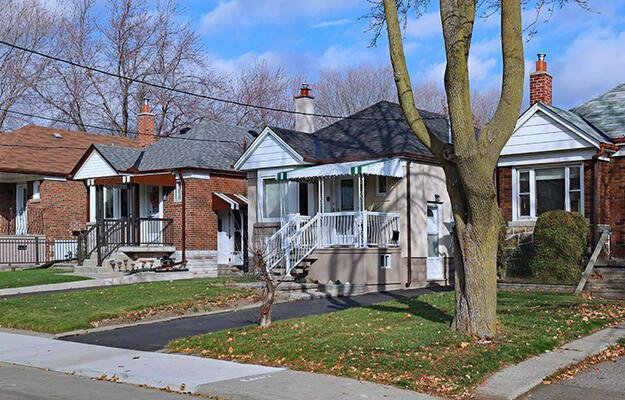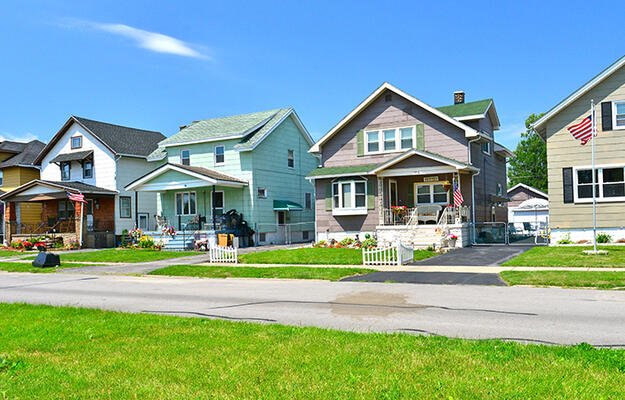
Olena Yakobchuk/Shutterstock
Black and Hispanic Homeowners Pay More in Property Taxes for the Same Bundle of Services
- Title:
-
The Assessment Gap: Racial Inequalities in Property Taxation
- Author:
-
Carlos F. Avenancio-León, Troup Howard
- Source:
- Publication Date:
-
2022
Property taxes, which fund everything from public schools to parks and roads, are meant to be ad valorem taxes, meaning they are calculated as a percentage of a home’s assessed value and all homeowners subject to taxation by the same set of governments should be paying an equal share of their home’s value. But in jurisdictions across the country, Black and Hispanic homeowners have been shown to pay disproportionately high taxes relative to their homes’ values, in part due to legacies of racial segregation and neighborhood inequality. The authors of this paper corroborate these local reports with a nationwide analysis of the gap in property tax assessments between white households and Black and Hispanic households. We've chosen to use the term "Hispanic" to align with the study, but recognize that not all members of the group identify with the term.
For their primary analysis, the authors used a comprehensive panel dataset with property-level records of assessments and transactions for 6.9 million homes in the United States from 2003 to 2016. They define a tax jurisdiction as the intersection of all taxing entities and holds intended taxation, as well as the public good provision attributed to that taxation. They limited the scope of their analysis to residential properties with one to four units given the significant variations in how commercial and multifamily properties are assessed and removed all California properties from the dataset because of stringent limitations on assessment practices under the state’s Proposition 13. Finally, they combined property records data with shape files for government boundaries to establish a property’s associated taxing jurisdiction and with Home Mortgage Disclosure Act data to determine the race and ethnicity of the homeowner.
To compare across homeowners, the authors calculated assessment ratios—the ratio of the assessed value of a property for property tax purposes to its market value. They used regression analysis to determine the existence and size of within-jurisdiction assessment ratio disparities by race and ethnicity, as well as spatial analysis at the census tract level to determine the correlation between assessment ratio and minority population share.
The authors also evaluated the effect of the property tax appeals process on assessment ratios by performing a case study using a comprehensive record of appeals submitted to the Cook County Assessor’s Office between 2002 and 2015.
Key Findings
- Within jurisdictions, assessment ratios were 12.7 percent higher for Black homeowners and 9.8 percent higher for Black or Hispanic homeowners relative to their white counterparts.
- Based on tax bills, effective property tax rates were 15 percent higher for Black homeowners and 11.4 percent higher for Black and Hispanic homeowners.
- Differences in assessment ratios cannot be explained by racial differences in transaction prices, meaning Black homeowners are not paying systematically more or less than white people for similar homes
- Because of residential segregation and racial sorting, Black and Hispanic homeowners face a different average set of neighborhood characteristics. Property tax assessments are less responsive to neighborhood characteristics than market values are, resulting in significant differences in assessment values by race.
- The assessment gap between white households and Black and Hispanic households is largest in the most segregated regions.
- In Cook County, Illinois, between 2002 and 2015, Black homeowners were less likely to appeal their assessed values, less likely to win when they did appeal, and received smaller reductions in their assessed values when they did win.
Policy Implications
- The authors note that race-neutral practices like property tax assessments can still generate inequality through systems that “mirror, export, and sometimes amplify inequities already ingrained in the fabric of US society, regardless of intent.” Race-conscious policymaking intended to correct for historic inequalities can help combat the effects of such systems.
- Policies that may improve property tax equity include implementing or improving oversight for assessments, expanding property tax relief programs, and reducing residential segregation and investing in historically excluded communities.


